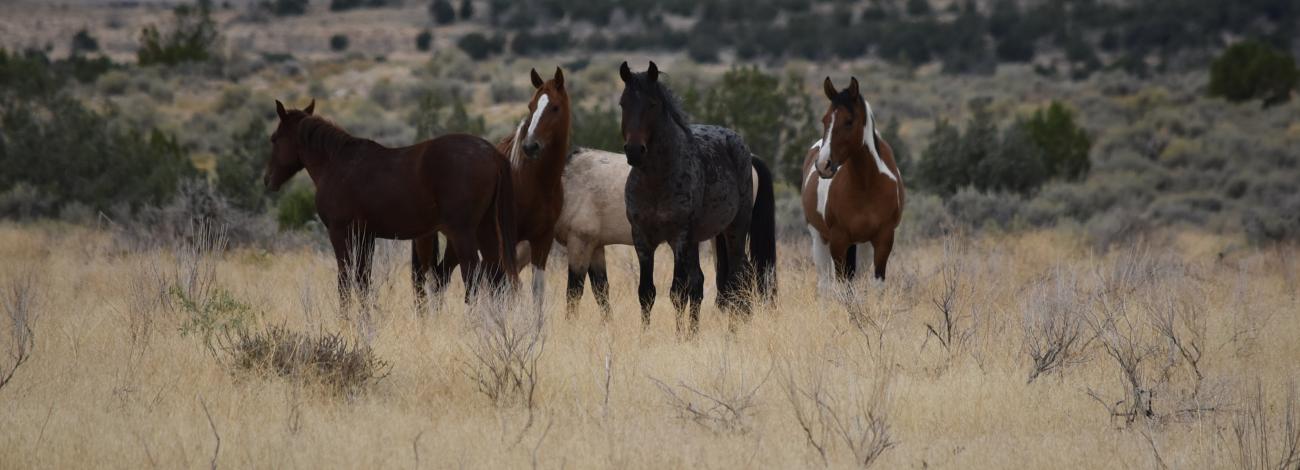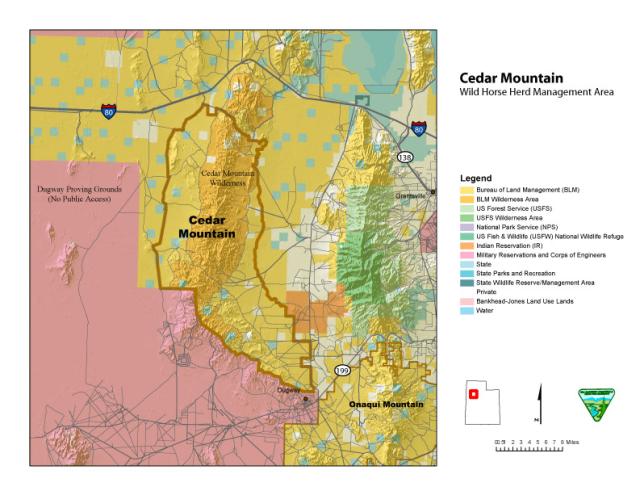
Cedar Mountain HMA
Wild horses have occupied the Cedar Mountains since the late 1800s. It is suggested that the original stock was controlled by the Standard Horse and Mule Company that provided remounts for the U.S. Army. However, many of the horses on the Cedar Mountains are descendants of horses that escaped from local ranches. In recent years, horses have been introduced from other Herd Management Areas from Nevada, Oregon, Wyoming and other Herd Management Areas from within Utah. The dominant colors within the herd area are bay and black. Other colors found include pinto, sorrel, red and blue roan, buckskin, palomino, and gray. The wild horses on the Cedars are classified as average in size. Mares weight 750 to 800 pounds and stallions weigh 850 to I,000 pounds.
Location
The Cedar Mountains Herd Management Area is located 45 miles west from Salt Lake City, Utah, and south of I-80. The Herd Management Area extends from Hastings Pass southward to the Dugway Proving Grounds.
Size
The Herd Management Area contains 204,674 acres of BLM lands, 6,919 acres of State lands, and privately owned land for a total of 211,593 acres.
Topography/Vegetation
Vegetation varies from salt desert shrub and sagebrush, to grass-juniper and juniper barren ground type at the higher elevations. Majority of the area is made up of cheatgrass as the dominant vegetation type.
The extreme valley bottoms on the east side of the Cedar Mountains are in the greasewood shrub type due to high exchangeable sodium. Annuals such as cheatgrass, Halogeton and Russian thistle have invaded large areas. A fire interval of three to five years has established in these areas. As a result, the salt desert shrub and sagebrush types are largely absent within cheatgrass areas. Furthermore, fire rehabilitation seedings on the bench areas have had limited reestablishment of shrubs. Cheatgrass and seeded wheat grasses have resulted in abundant forage throughout Skull Valley.
Water sources within the Herd Management Area include stock reservoirs, springs and intermittent streams fed by winter snows and spring runoff. Resource damage has occurred especially near water sources where distinct horse trailing is evident. Water flow from sources in the area has decreased and, in some instances, ceased altogether. Emergency gathers were completed in 2004 and 2018 due to the lack of water resources for the horses in the Herd Management Area.
Wildlife
The Cedar Mountain Herd Management Area provides important forage, water, shade, and cover for a variety of wildlife. The higher elevation portion of this area is dominated by juniper and provides for species such as elk, mule deer and various migratory birds. The foothills consist of desert shrub and species like pronghorn which prefer this type of habitat.
The foothills of the Cedar Mountains provide breeding, nesting, and foraging habitat for numerous raptor species. Some of the raptor species that nest and/or use the area include golden eagle, prairie falcon, red-tailed hawks, Swainson's hawk, ferruginous hawks, a variety of owl species and other raptors. Migratory birds in North America are primarily neotropical species that nest in the United States during the summer and migrate south. The Herd Management Area is utilized by juniper-obligate and sage-obligate bird species as well as transient and migratory populations of birds in the spring and fall of each year.
Appropriate Management Level
The appropriate management level (AML) was increased and adjusted in 2002 to a range of 190 to 390 animals, based on the following factors: a need to balance the number of animals with the available forage and water production during frequent and prolonged drought periods.
Viewing Opportunities
From Salt Lake City, Take 1-80 40 miles west of Salt Lake City to the Dugway Road (exit 77). Travel south approximately 17 miles to the Skull Valley Ranch. At the south end of the ranch, turn west at the BLM sign marked "Rydalch Pass-Eight Mile Spring." Proceed west approximately one mile to another BLM sign marked "Rydalch" and turn left. Travel across Skull Valley 14 miles to the Cedar Mountains. Horses can be viewed along the east or west side of the Cedars south to the Dugway Proving Grounds fence, and north to Hastings Pass. Do not enter the Military area. Wild horses are naturally wary. They are best viewed with binoculars at a distance. When approached, they will normally spook and run for cover.
Special Travel Conditions
Road conditions along the Rydalch Road are influenced by moisture. Roads in the Cedars are very slick and muddy when wet, and dusty during extended dry periods. When dry, the Rydalch Road can be driven by a medium profile vehicle, although side roads can be hazardous. When wet, high clearance vehicles are recommended on all Cedar Mountain roads.

